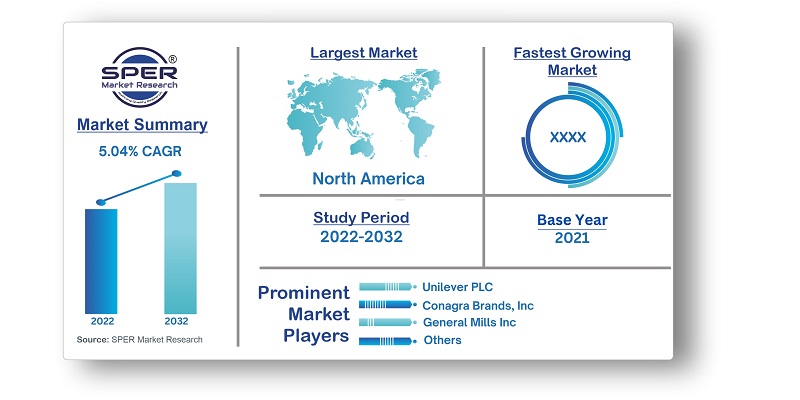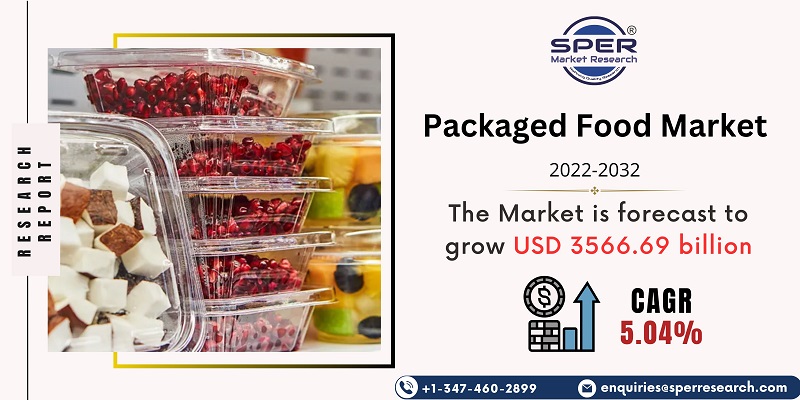
Packaged Food Market Growth, Trends, Size, Revenue, Share, Competition and Future Challenges
Global Packaged Food Market Size- By Sales Channel, By Product Type, By Packaging Type- Regional Outlook, Competitive Strategies and Segment Forecasts to 2032
| Published: Nov-2022 | Report ID: FOOD2224 | Pages: 1 - 256 | Formats*: |
| Category : Food & Beverages | |||
- Convenience and Time-Saving: Packaged foods offer convenience and time-saving benefits, catering to the busy lifestyles of consumers. Ready-to-eat meals, snacks, and pre-packaged ingredients reduce preparation time and effort in cooking, making them attractive to individuals and families with hectic schedules.
- The increased preference for convenience items feeds the rising demand for packaged food products due to their convenience and time-saving benefits over cooking from scratch. The packaged food market is expanding rapidly as a result of the increasing volume of the hectic lifestyle of the working population around the world, which is significantly boosting the packaged food market.


| Report Metric | Details |
| Market size available for years | 2019-2032 |
| Base year considered | 2021 |
| Forecast period | 2022-2032 |
| Segments covered | By Sales Channel, By Product Type, By Packaging Type |
| Regions covered | North America, Asia-Pacific, Latin America, Middle East & Africa and Europe. |
| Companies Covered | Unilever PLC, Conagra Brands, Inc., General Mills Inc., Danone SA, Tyson Foods, Inc., Cargill, Incorporated, Nestle SA, Kellogg Co., Hormel Foods Corporation, PepsiCo, Inc., The Kraft Heinz Company, Mondelz Global LLC, JBS SA, WH Groups, The Coca-Cola Company, Others. |
- Consumers seeking convenience
- Families and household consumers
- Foodservice and hospitality industry
- Health-conscious consumers
- On-the-go consumers
- Others
| By Product Type: |
|
| By Packaging Type: |
|
- Global Packaged Food Market Size (FY’2022-FY’2032)
- Overview of Global Packaged Food Market
- Segmentation of Global Packaged Food Market By Sales Channel (Online Stores, Speciality Stores, Supermarket/Hypermarket, Grocery Stores, Convenience Stores, Others)
- Segmentation of Global Packaged Food Market By Product Type (Dairy Products, Beverage, Snacks, Bakery, Breakfast Cereals, Confectionery, Ready Meals, Packaged Produced, Others)
- Segmentation of Global Packaged Food Market By Packaging Type (Plastic Packaging, Tetra Pack, Metal Cans, Others)
- Statistical Snap of Global Packaged Food Market
- Expansion Analysis of Global Packaged Food Market
- Problems and Obstacles in Global Packaged Food Market
- Competitive Landscape in the Global Packaged Food Market
- Impact of COVID-19 and Demonetization on Global Packaged Food Market
- Details on Current Investment in Global Packaged Food Market
- Competitive Analysis of Global Packaged Food Market
- Prominent Players in the Global Packaged Food Market
- SWOT Analysis of Global Packaged Food Market
- Global Packaged Food Market Future Outlook and Projections (FY’2022-FY’2032)
- Recommendations from Analyst
1.1. Scope of the report1.2. Market segment analysis
2.1.1 Secondary data2.1.2 Primary data2.1.3 SPER’s internal database2.1.4 Premium insight from KOL’s
4.1. Driver, Restraint, Opportunity and Challenges analysis
4.1.1 Drivers4.1.2 Restraints4.1.3 Opportunities4.1.4 Challenges
4.2. COVID-19 Impacts of the Global Packaged Food Market
5.1. SWOT analysis
5.1.1 Strengths5.1.2 Weaknesses5.1.3 Opportunities5.1.4 Threats
5.2. PESTEL analysis
5.2.1 Political landscape5.2.2 Economic landscape5.2.3 Social landscape5.2.4 Technological landscape5.2.5 Environmental landscape5.2.6 Legal landscape
5.3. PORTER’S five forces analysis
5.3.1 Bargaining power of suppliers5.3.2 Bargaining power of Buyers5.3.3 Threat of Substitute5.3.4 Threat of new entrant5.3.5 Competitive rivalry
5.4. Heat map analysis
6.1 Online Stores6.2 Speciality Stores6.3 Supermarket/Hypermarket6.4 Grocery Stores6.5 Convenience Stores6.6 Others
7.1 Dairy Products7.2 Beverage7.3 Snacks7.4 Bakery7.5 Breakfast Cereals7.6 Confectionery7.7 Ready Meals7.8 Packaged Produced7.9 Others
8.1 Metal Cans8.2 Plastic Packaging8.3 Tetra Pack8.4 Others
9.1 North America
9.1.1. United States9.1.2. Canada9.1.3. Mexico
9.2 Europe
9.2.1. Germany9.2.2. United Kingdom9.2.3. France9.2.4. Italy9.2.5. Spain9.2.6. Rest of Europe
9.3 Asia-Pacific
9.3.1. China9.3.2. Japan9.3.3. India9.3.4. Australia9.3.5. South Korea9.3.6. Rest of Asia-Pacific
9.4 South America
9.4.1. Brazil9.4.2. Argentina9.4.3. Rest of South America
9.5 Middle East & Africa
9.5.1. Kingdom of Saudi Arabia9.5.2. United Arab Emirates9.5.3. Rest of Middle East & Africa
10.1 Cargill, Incorporated
10.1.1. Company details10.1.2. Financial outlook10.1.3. Product summary10.1.4. Recent developments
10.2 Conagra Brands, Inc.
10.2.1. Company details10.2.2. Financial outlook10.2.3. Product summary10.2.4. Recent developments
10.3 Danone SA
10.3.1. Company details10.3.2. Financial outlook10.3.3. Product summary10.3.4. Recent developments
10.4 General Mills Inc.
10.4.1. Company details10.4.2. Financial outlook10.4.3. Product summary10.4.4. Recent developments
10.5 Hormel Foods Corporation
10.5.1. Company details10.5.2. Financial outlook10.5.3. Product summary10.5.4. Recent developments
10.6 JBS SA
10.6.1. Company details10.6.2. Financial outlook10.6.3. Product summary10.6.4. Recent developments
10.7 Kellogg Co.
10.7.1. Company details10.7.2. Financial outlook10.7.3. Product summary10.7.4. Recent developments
10.8 Mondelz Global LLC
10.8.1. Company details10.8.2. Financial outlook10.8.3. Product summary10.8.4. Recent developments
10.9 Nestle SA
10.9.1. Company details10.9.2. Financial outlook10.9.3. Product summary10.9.4. Recent developments
10.10. PepsiCo, Inc.
10.10.1. Company details10.10.2. Financial outlook10.10.3. Product summary10.10.4. Recent developments
10.11 The Coca-Cola Company
10.11.1. Company details10.11.2. Financial outlook10.11.3. Product summary10.11.4. Recent developments
10.12. The Kraft Heinz Company
10.12.1. Company details10.12.2. Financial outlook10.12.3. Product summary10.12.4. Recent developments
10.13. Tyson Foods, Inc.
10.13.1. Company details10.13.2. Financial outlook10.13.3. Product summary10.13.4. Recent developments
10.14 Unilever PLC
10.14.1. Company detail10.14.2. Financial outlook10.14.3. Product summary10.14.4. Recent developments
10.15 WH Group
10.15.1. Company details10.15.2. Financial outlook10.15.3. Product summary10.15.4. Recent developments
SPER Market Research’s methodology uses great emphasis on primary research to ensure that the market intelligence insights are up to date, reliable and accurate. Primary interviews are done with players involved in each phase of a supply chain to analyze the market forecasting. The secondary research method is used to help you fully understand how the future markets and the spending patterns look likes.
The report is based on in-depth qualitative and quantitative analysis of the Product Market. The quantitative analysis involves the application of various projection and sampling techniques. The qualitative analysis involves primary interviews, surveys, and vendor briefings. The data gathered as a result of these processes are validated through experts opinion. Our research methodology entails an ideal mixture of primary and secondary initiatives.



Frequently Asked Questions About This Report
PLACE AN ORDER
Year End Discount
Sample Report
Pre-Purchase Inquiry
NEED CUSTOMIZATION?
Request CustomizationCALL OR EMAIL US
100% Secure Payment






Related Reports
Our Global Clients
Our data-driven insights have influenced the strategy of 200+ reputed companies across the globe.




















